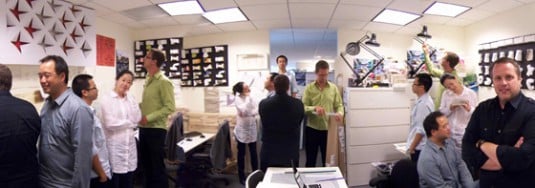
July 23, 2011
Towards a Car-less California
Traffic ahead of the I-405 shutdown, photo via the Daily Mail. When America’s busiest freeway, Interstate 405, closed temporarily for mandatory construction from July 16-17, all of Los Angeles broke out in panic as drivers canceled weekend plans and signs flashed on every freeway in the region preparing locals for anticipated delays. The LAPD even […]
Traffic ahead of the I-405 shutdown, photo via the Daily Mail.
When America’s busiest freeway, Interstate 405, closed temporarily for mandatory construction from July 16-17, all of Los Angeles broke out in panic as drivers canceled weekend plans and signs flashed on every freeway in the region preparing locals for anticipated delays. The LAPD even recruited popular celebrities on Twitter, including Ashton Kutcher and Kim Kardashian, to broadcast a warning so people would stay off the roads, during what was referred to as the “Carmaggedon.” But 53-hours of blocked access and apocalyptic panic later, LA did not find itself in a hopeless gridlock. Instead, the anticlimactic closure proved how much Californians depended on the 10-mile route, yet how surprisingly easy it also was to abandon their cars for 2 days.
When the freeway opened up again, the city quickly returned to its usual congested state as drivers hopped back into their cars. But now that LA has caught a glimpse of the city with less traffic and carbon footprint, it’s tempting to want to make it a sustained reality. While a car-free California may be too ambitious and premature given the culture and structure the cities were built on, it isn’t stopping various groups from initiating a movement. In efforts to shift people on the West Coast from their cars to public transit, companies have been rethinking the structure of their transit system, proposing technological and conceptual designs as solutions.
 The design team of Gensler’s Network_LA Transit.
The design team of Gensler’s Network_LA Transit.
Gensler Los Angeles recently designed a phone-based application, Network_LA Transit, which generates flexible vehicle choices, by managing individual commuting needs through a system of data. The network adapts and restructures existing transportation systems such as bicycles, scooters and the LA Metro, while personalizing them to individual commuter needs. It works by keeping current transportation stops, but also liberating the routes to respond to user demands. Network_LA Transit integrates real-time data from ground transport, stops and users through a GPS application, tripFinder, to generate optimal itineraries for each user. The user-driven on-demand system resembles the New York-based social transit system, Weeels that promotes the sharing of for-hire vehicles. Having tried Weeels before, I understand that shortcomings of the program are due to the assumption that most people own a smart phone, and are enthusiastic about sharing a cab with strangers. As a social application, unless Network_LA Transit is embraced by a large population of participants, its implementation may not prove to be effective.
Over in San Francisco, Bay Area Rapid Transit (BART) has turned to the design-consulting division at BMW to design their new fleet of trains. BART trains are currently the oldest in the country, that are still in operation, and the system recognizes the need to upgrade. Realizing that the new design has to appeal to its potential users in order to increase ridership, BART created a mobile seat lab in all of its nine districts to allow people to say what kind of seat material, width and height they would prefer. Among the 2,200 responses, passengers have expressed the need for wider aisles, that they preferred cleanliness to comfort and felt strongly against upholstery on seats. Following this research, 800 to 1,000 redesigned trains will go through several iterations of testing and mock-ups before they are rolled out in 2020. But hiring a high-profile design team isn’t cheap, so in order for locals to give up driving and opt for BART instead, the trains not only need to be redesigned for comfort, safety and convenience but also appeal to commuters economically.
Last weekend’s Carmaggedon demonstrated that Californians are still very much dependent on driving in 2011, and to imagine a weekend without it, induces widespread fear. Perhaps the two-day shut down was just too sudden for most people. With well-researched design solutions and careful transition, it’s not impossible to move towards more alternatives to driving and restructure the West Coast in a more transit-friendly way. As proven by Carmaggedon, this movement won’t happen overnight, but it’s a good vision that many are already working towards.





